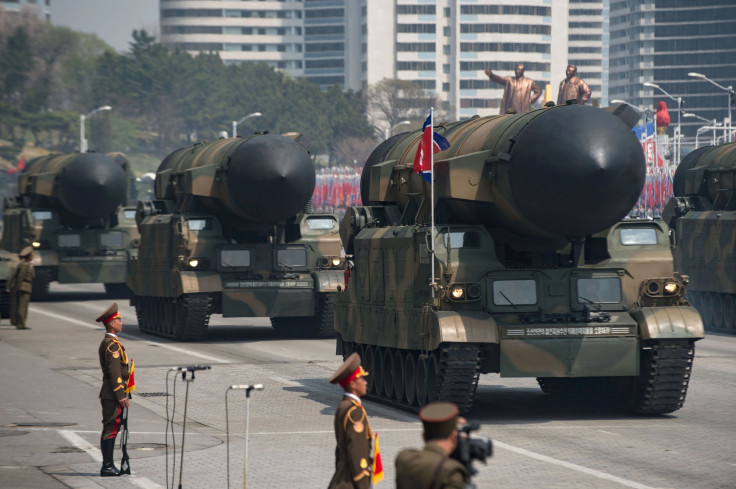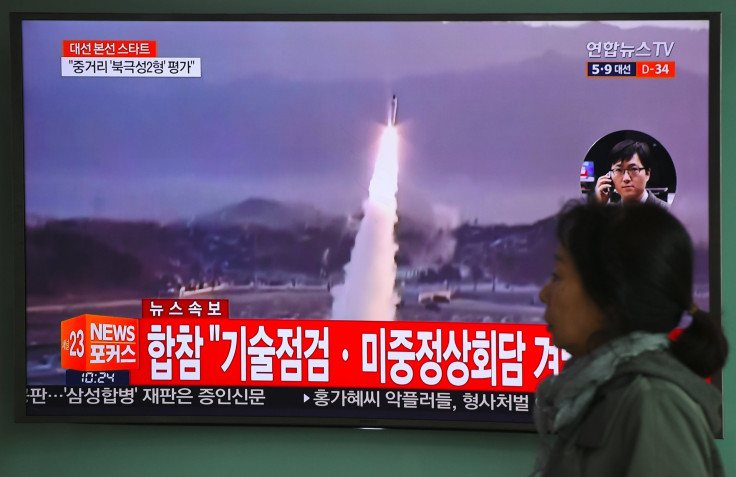Is North Korea Preparing For Nuclear War? Kim Jong Un's Military Fires 'Unidentified Projectile'

North Korea launched an unidentified projectile early Saturday morning, the South Korean military confirmed to Reuters. While the object’s exact nature remained unknown, it was likely a ballistic missile.
If the launch was, in fact, a ballistic missile, it would be the first the North fired in the two weeks since its last missile test, which failed a mere two minutes into its flight. North Korea has launched four unsuccessful missile tests over the past two months. Despite the tests’ ultimate failure, the North likely gleaned significant technical knowledge from the launches, according to Reuters.
It’s unclear what the launch means for the already tenuous relationship between the United States and North Korea. Both regions have warned each other against taking military action in recent months. President Donald Trump and senior officials in his administration have said that no action is off the table.
Read: How Far Can North Korea's Nuclear Missiles Reach?
“There is a chance that we could end up having a major, major conflict with North Korea,” the president told Reuters in April. “We’d love to solve things diplomatically by it’s very difficult.”

Vice President Mike Pence reiterated the point during a visit to the demilitarized zone between North and South Korea the same month. Pence essentially ushered in a new era of relations between the U.S. and North Korea, saying the policy of “strategic patience” was no longer adequate.
“Since 1992, the United States and our allies have stood together for a denuclearized Korean Peninsula,” Pence said. “We hope to achieve this objective through peaceable means, but all options are on the table.”
The U.S. began installation of its missile defense system, or Terminal High Altitude Area Defense system (THAAD), in South Korea in April. The system would, ideally, decimate North Korean missiles before they had a chance to successfully hit their targets. The North, as well as protesters in South Korea, denounced the move by saying it created even more tension in an already strained relationship.
“By relentlessly bringing in a number of strategic nuclear assets to the Korean peninsula, the U.S. is gravely threatening the peace and safety and driving the situation to the brink of nuclear war,” North Korean officials said in a statement. “This has created a dangerous situation in which thermo-nuclear war may break out at any moment.”
Read: North Korea Accuses U.S. Of Trying To Assassinate Kim Jong Un
The secretive nature of North Korean military operations makes it near-impossible to discern the exact capabilities of its existing missiles. Military officials have said recently that while the North likely does not yet have the ability to fire long-range missiles that would reach places like the U.S., they’re not far off from the technology. Estimates still vary about the exact distance the missiles might currently be able to reach. Some suggest they could make it as far as 4,000 km, allowing the country to reach targets like U.S. military bases in Guam.
Outside nations have urged North Korea and the U.S. to de-escalate the situation before it spirals out of control.
“The United States and North Korea are engaging in tit for tat,” China’s foreign ministry, Wang Yi, said in April. “We call on all parties to refrain from provoking and threatening each other, whether words or actions, and not let the situation get to an irreversible and unmanageable stage. Force cannot solve the problem, dialogue can be the only channel to resolve the problem.”

© Copyright IBTimes 2025. All rights reserved.





















